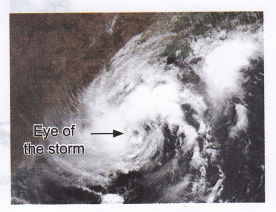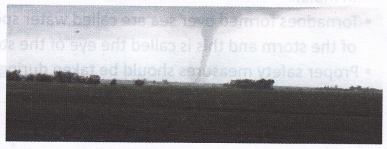What Is A Cyclone And How It Is Formed
Cyclones (or hurricanes) develop over the warm moist waters of the oceans near the equator. The water heats up the atmosphere above it. Warm air rises and cooler air from the surroundings rushes in to take its place. This results in a number of small thunderstorms over the ocean. All these small storms then merge into one complex storm.

If a storm stays over water, it will continue to grow. Due to the rotation of the Earth, these winds start spinning. Wind speeds at this time are less than 60 km/h. If the wind speed climbs above 64 km/h, it is called a tropical storm. Some tropical storms die out in a few days, while others may continue to grow and develop into full-fledged cyclones with wind speeds well over 120 km/h.
As a cyclone forms, the pressure falls in the centre of the storm and this is called the eye of the storm. It could be 16 to 32 km across. Although there are strong winds around the eye, within it everything is calm. Cyclones can be huge. Some can even be 800 km across.
Damage Caused by a Cyclone
Cyclone winds travel at very great speeds. When a cyclone strikes, trees can be uprooted and buildings flattened. It is accompanied by very heavy rains. Cyclones can cover a large area. They are shaped like huge spirals and can be seen and tracked by satellites. Another interesting fact is that they circulate counterclockwise in the Northern Hemisphere and clockwise in the Southern Hemisphere.

Tornadoes
A tornado is a violent spinning storm typically shaped like a funnel with the narrow end on the ground.
Tornadoes develop from thunderstorms and are formed mostly on land (tornadoes formed over sea are called water spouts). They are the most violent small-scale storms on Earth. The fast swirling winds may reach speeds of over 500 km/h, destroying virtually everything in their path. Unlike hurricanes, tornadoes are usually narrow, about 0.5 km wide and rarely do they move beyond 20 km.

Safety Measures During a Storm
When a cyclonic storm moves towards land, it comes with heavy rains, strong winds, and high waves. The high waves, called storm surge, are very dangerous and people should stay away from the ocean during a cyclonic storm as they can be washed away.
Some safety measures one should take during a cyclone warning are given below.
- Remove any dead trees or overhanging branches, loose roofing materials, etc., that could blow away.
- Stay indoors as far as possible and move to a shelter agreed upon.
- Secure windows and stay away from them.
- You will not be able to outrun a tornado in your car, so please don’t try to do it.
- Do not take shelter under a tree, as trees can be uprooted due to heavy rain and strong winds.
- Watch out for flying debris and loose objects that may fall.
- Avoid anything that may touch electricity lines. Wet ground or puddles of water will conduct electricity.
- People in low-lying areas and near the coastline should be evacuated.
- Fishermen should not go out to sea after a cyclone warning.
- Enough food, water, and emergency medicines should be kept in the house as it may be necessary to stay indoors for a few days.
- A good supply of candles, lanterns, or battery-operated torch lights with lots of spare batteries
- should be kept in the house as you may have to go without electricity for a day or two during a cyclone.
